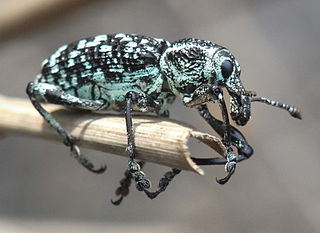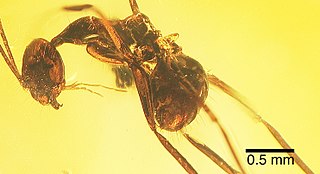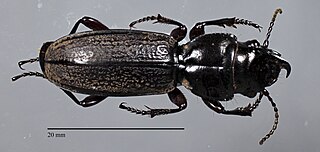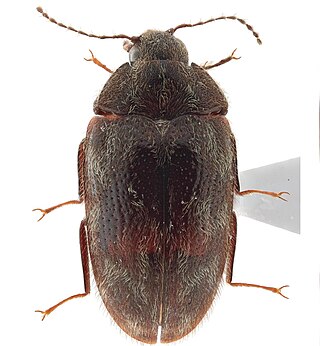
Myxophaga is the second-smallest suborder of the Coleoptera after Archostemata, consisting of roughly 65 species of small to minute beetles in four families. The members of this suborder are aquatic and semiaquatic, and feed on algae.

George Charles Champion was an English entomologist specialising in the study of beetles.

Chrysolopus spectabilis is a species of weevil found in south-eastern Australia. It was discovered during James Cook's first voyage, and became one of the first insects to be described from Australia. The weevil measures up to 25 mm (1.0 in) long and includes distinctive metallic green and black scales. It is found only on 28 species of the plant genus Acacia.

Zatania electra is an extinct species of ant in the subfamily Formicinae known from three possibly Miocene fossils found on Hispaniola. Z. electra is one of several Zatania species found in the Greater Antilles.
Cyclocephala nodanotherwon is a species of rhinoceros beetle in the scarab family. It has only been found in Amazonas, Brazil. Brett C. Ratcliffe described and named the species in 1992.

Colilodion schulzi is a species of beetles belonging to the family Staphylinidae. This small, robust, reddish-brown rove beetle is known from a single specimen, a 2.37 millimetres (0.093 in) long female. It resembles the species C. concinnus and C. inopinatus with its enlarged antennomeres III, but it is easily distinguished by the greater maximum width and less variable width of these appendages, and by other morphological characteristics. Although its ecology is unknown, the presence of trichomes and the knowledge of related species, such as Staphylinidae suggests that this insect is myrmecophilous. The holotype was collected in 2009 in Palawan (Philippines) while sifting plant debris in a coniferous forest. The species was described in 2016 by the coleopterists Zi-Wei Yin from Shanghai Normal University and Giulio Cuccodoro from the Natural History Museum of Geneva, where the type specimen is part of the collection. The taxon's specific denomination is dedicated to the German myrmecologist Andreas Schulz, collector of the specimen.

Mecodema chaiup is a large-bodied ground beetle species found in Mohi Bush Scenic Reserve, Hawke's Bay, New Zealand. A single specimen was found beneath a large log in 2008 by D.S. Seldon and C.P. Martin. Since then a number of intensive pitfall trap surveys of Mohi Bush have failed to collect further specimens.

Mecodema kokoromatua is a medium-bodied ground beetle endemic to Northland, New Zealand. Its range is restricted to coastal forest behind the sand dunes and below the southern areas of the Ahipara Escarpment, Herekino, Northland, New Zealand. This species is within the curvidens species group and is related to the geographically widespread M. parataiko.
Phaeochrous elevatus, is a species of scavenger scarab beetle native to South India and Sri Lanka.
Harmatelia bilinea, is a species of firefly beetle endemic to Sri Lanka.
Callispa krishnashunda, is a species of leaf beetle found in Sri Lanka.
Callispa nigritarsata, is a species of leaf beetle found in Sri Lanka.
Sceloenopla octopunctata, is a species of leaf beetle found in India and Sri Lanka.

Caccothryptus larryi is a species of minute marsh-loving beetle in the subfamily Limnichinae. The species was described alongside five other Caccothryptus species by Natural History Museum entomologist Keita Matsumoto in 2021, using specimens gathered in 1953 by Harry George Champion in Haldwani, India. Both of the c. larryi specimens featured genital structures distinct from Champion's initial classification of C. ripicola. The species was named for Larry, the Chief Mouser to the Cabinet Office at the British Prime Minister's residence at 10 Downing Street.

Caccothryptus tardarsauceae is a species of minute marsh-loving beetle in the subfamily Limnichinae. The species was described alongside five other Caccothryptus species by Natural History Museum entomologist Keita Matsumoto in 2021, using a male specimen gathered in 1953 by Harry George Champion in Haldwani, India. One of Champion's specimens was distinguished from its initial classification of C. ripicola due to distinct genital structures. The species was named for Tardar Sauce, also known as Grumpy Cat, a pet cat which had become an internet celebrity prior to her death in 2019.

Caccothryptus arakawae is a species of minute marsh-loving beetle in the subfamily Limnichinae. The species was described alongside five other Caccothryptus species by Natural History Museum entomologist Keita Matsumoto in 2021, using specimens gathered by Martin J. D. Brendell at Kathmandu, Nepal in 1983. Six of Brendell's specimens were distinguished from its initial classification of Caccothryptus testudo due to distinct genital structures. The species was named for Hiromu Arakawa, the creator of manga series Fullmetal Alchemist.

Caccothryptus brendelli is a species of minute marsh-loving beetle in the subfamily Limnichinae. The species was described alongside five other Caccothryptus species by Natural History Museum entomologist Keita Matsumoto in 2021, using specimens gathered by Martin J. D. Brendell at Kathmandu, Nepal in 1983. One of Brendell's specimens were distinguished from Caccothryptus testudo due to distinct genital structures and labeled C. brendelli after Brendell.

Caccothryptus abboti is a species of minute marsh-loving beetle in the subfamily Limnichinae. The species was described alongside five other Caccothryptus species by Natural History Museum entomologist Keita Matsumoto in 2021, using specimens gathered in 1953 by Harry George Champion in Haldwani, India alongside an earlier 1925 specimen collected nearby. Like the other Caccothryptus species described by Matsumoto, it was distinguished from its original classification of C. testudo due to differences in the shape of its genitalia. One specimen collected by Champion was identified as the holotype for C. abboti and named for English radio presenter Nick Abbot.
Caccothryptus yunnanensis is a species of minute marsh-loving beetle in the subfamily Limnichinae. The species was described in 2018 by enomologist Hiroyuki Yoshitomi. Although part of the species group C. testudo, it is related to the C. compactus species C. chayuensis) and C. thai due to serrae due to their shared small notches along the median lobe. It is distinguished from these due to its straight parameres, which are curved in C. chayuensis and C. thai. C. yunnanensis specimens were collected by Yu-Tang Wang across the Chinese provinces of Guizhou and Yunnan, the latter of which gave the species its name. It is almost entirely black in coloration, except for dark and light brown in its antennae and legs. It has an average length of around 5 mm. The holotype of C. yunnanensis is a male collected in Xima, Yunnan in 2014.
Caccothryptus is a genus of minute marsh-loving beetle in the subfamily Limnichinae. The genus was first described by entomologist David Sharp in 1902, with C. compactus as the type species.












